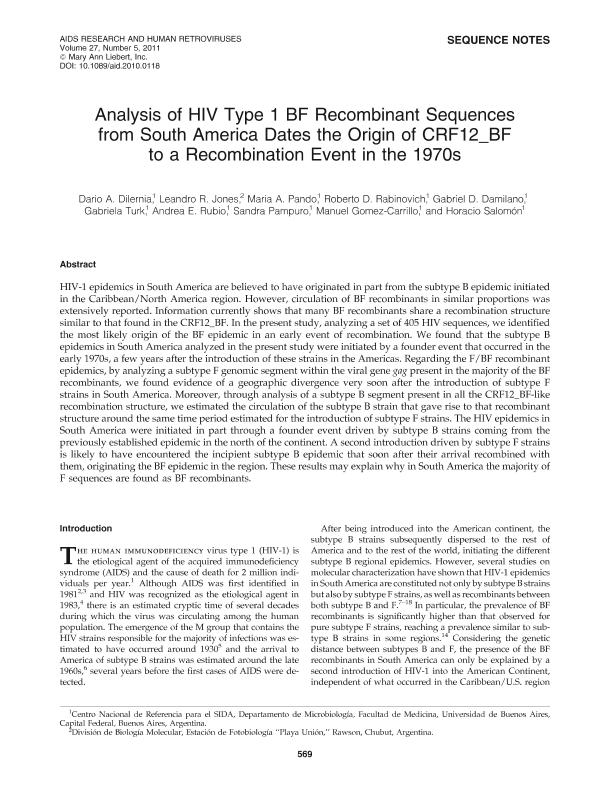Artículo
Analysis of HIV type 1 BF recombinant sequences from south america dates the origin of CRF12-BF to a recombination event in the 1970s
Dilernia, Darío Alberto ; Jones, Leandro Roberto
; Jones, Leandro Roberto ; Pando, María de los Ángeles
; Pando, María de los Ángeles ; Rabinovich, Roberto Daniel
; Rabinovich, Roberto Daniel ; Damilano, Gabriel Dario; Turk, Gabriela Julia Ana
; Damilano, Gabriel Dario; Turk, Gabriela Julia Ana ; Rubio, Andrea; Pampuro, Sandra Esther
; Rubio, Andrea; Pampuro, Sandra Esther ; Gómez Carrillo, Manuel
; Gómez Carrillo, Manuel ; Salomon, Horacio Eduardo
; Salomon, Horacio Eduardo
 ; Jones, Leandro Roberto
; Jones, Leandro Roberto ; Pando, María de los Ángeles
; Pando, María de los Ángeles ; Rabinovich, Roberto Daniel
; Rabinovich, Roberto Daniel ; Damilano, Gabriel Dario; Turk, Gabriela Julia Ana
; Damilano, Gabriel Dario; Turk, Gabriela Julia Ana ; Rubio, Andrea; Pampuro, Sandra Esther
; Rubio, Andrea; Pampuro, Sandra Esther ; Gómez Carrillo, Manuel
; Gómez Carrillo, Manuel ; Salomon, Horacio Eduardo
; Salomon, Horacio Eduardo
Fecha de publicación:
05/2011
Editorial:
Mary Ann Liebert
Revista:
Aids Research and Human Retroviruses
ISSN:
0889-2229
Idioma:
Inglés
Tipo de recurso:
Artículo publicado
Clasificación temática:
Resumen
HIV-1 epidemics in South America are believed to have originated in part from the subtype B epidemic initiated in the Caribbean/North America region. However, circulation of BF recombinants in similar proportions was extensively reported. Information currently shows that many BF recombinants share a recombination structure similar to that found in the CRF12-BF. In the present study, analyzing a set of 405 HIV sequences, we identified the most likely origin of the BF epidemic in an early event of recombination. We found that the subtype B epidemics in South America analyzed in the present study were initiated by a founder event that occurred in the early 1970s, a few years after the introduction of these strains in the Americas. Regarding the F/BF recombinant epidemics, by analyzing a subtype F genomic segment within the viral gene gag present in the majority of the BF recombinants, we found evidence of a geographic divergence very soon after the introduction of subtype F strains in South America. Moreover, through analysis of a subtype B segment present in all the CRF12-BF-like recombination structure, we estimated the circulation of the subtype B strain that gave rise to that recombinant structure around the same time period estimated for the introduction of subtype F strains. The HIV epidemics in South America were initiated in part through a founder event driven by subtype B strains coming from the previously established epidemic in the north of the continent. A second introduction driven by subtype F strains is likely to have encountered the incipient subtype B epidemic that soon after their arrival recombined with them, originating the BF epidemic in the region. These results may explain why in South America the majority of F sequences are found as BF recombinants. © Copyright 2011, Mary Ann Liebert, Inc.
Palabras clave:
No Corresponde
Archivos asociados
Licencia
Identificadores
Colecciones
Articulos(OCA HOUSSAY)
Articulos de OFICINA DE COORDINACION ADMINISTRATIVA HOUSSAY
Articulos de OFICINA DE COORDINACION ADMINISTRATIVA HOUSSAY
Articulos(SEDE CENTRAL)
Articulos de SEDE CENTRAL
Articulos de SEDE CENTRAL
Citación
Dilernia, Darío Alberto; Jones, Leandro Roberto; Pando, María de los Ángeles; Rabinovich, Roberto Daniel; Damilano, Gabriel Dario; et al.; Analysis of HIV type 1 BF recombinant sequences from south america dates the origin of CRF12-BF to a recombination event in the 1970s; Mary Ann Liebert; Aids Research and Human Retroviruses; 27; 5; 5-2011; 569-578
Compartir
Altmétricas



